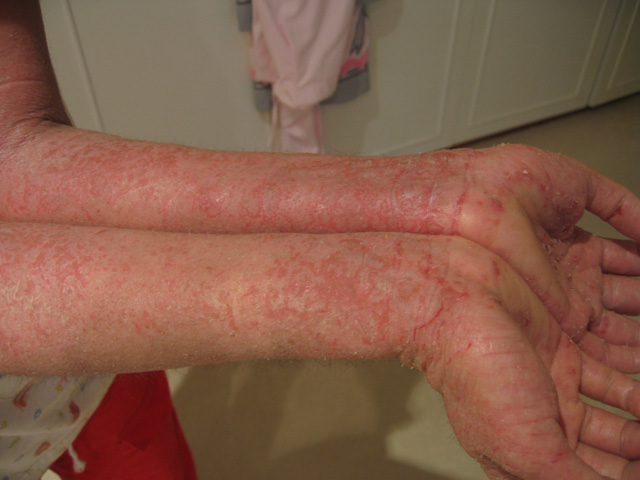Difference Between Eczema and Ringworm
We are afflicted by many different skin problems out of which the commonest are eczema and ringworm infection. Both these conditions present with some peculiar distinguishing signs and symptoms.
Symptoms of eczema
Eczema or atopic dermatitis is an inflammation of the skin. It affects almost 3.5% of the population with kids being more vulnerable as compared to adults. Sometimes children outgrow this condition as they reach adult hood but in some cases it persists. The condition is not contagious.
The patient visits the dermatologist with itchy red skin with slight bleeding and crusting patches. Eczema covers a wide range of skin conditions such as recurrent skin rash, dry, red, itchy skin, bleeding, blistering skin, crusting, flaking and cracking skin occurring due to unknown pathology. Some areas that have healed, give a temporarily discoloured look. The patients are advised not to scratch the lesion as it can increase the rash. Children tend to have few areas of thickened dry skin on the face, hands, neck and inner side of the elbow and knee which indicates the chronicity of the condition.
The exact cause of the condition is not yet known however some theories have been proposed. It has been linked to genes as it has been found more commonly in children born to older mothers. Most accepted theory is that it is due to dysfunction of the auto immune system towards the skin. Other factors like environment, sensitive skin, defective skin, dry and cold climates, nuts and dairy products, emotional stress and increased pollution tend to aggravate the condition.
There are different types of eczemas:
-
Allergic contact eczema (dermatitis) – occurs when the skin comes in contact with a foreign object which triggers an immune reaction.
-
Contact eczema – when a localized part of skin comes in contact with an irritant triggering a localized allergic reaction.
-
Dyshidriotic eczema – blisters on the palms and soles due to irritation of skin in these areas.
-
Neurodermatitis – scaly patches of skin on head, forearms, wrists, lower legs caused by localized itch such as an insect bite
-
Nummular eczema – circular patches of irritated skin which is crusted, scaling and itchy
-
Seborrheic eczema – oily, scaly yellowish patches of skin, usually on scalp and face
-
Stasis dermatitis – skin irritation on lower legs, usually related to circulatory problems
Treatment of eczema includes liberal application of moisturiser just after warm water bath to lock in the moisturiser. It is also advised to avoid exposure to extreme hot and cold environments. Keep away from stimulants that trigger eczema. In severe cases steroid creams for topical application are advised. If these do not help then, creams with calcineurin inhibitors are prescribed. Ultraviolet therapy using UVA and UVB alone or in combination is also effective in some cases. Oral medications to suppress the immune system may also be advised in some cases. Wearing soft loose fabrics is advised.
Symptoms of Ringworm
Ringworm is a fungal infection caused by a fungus called tinea. Depending on the location of skin lesion the condition can be named as tinea capitis (rash on scalp), tinea corporis (rash on body), tinea pedis (rash on feet), tinea cruris (rash in groin/jock itch) etc.
This condition is more common in children as compared to adults. It is contagious and can be transmitted through touch with infected persons or pets and even at times contact with soil. You can also acquire the infection if you use personal belongings like towel, comb, and hair brush of an infected person. The child presents with red scaly skin with a circular rash. There may be blisters and oozing of blood in some cases. The rash has a distinct margin. If the infection affects the scalp there is hair loss. The condition normally occurs in hot and moist climates.
Microscopic examination and culture sensitivity tests of the skin scrapings can help in making the diagnosis. Fungi can survive on the uppermost dead layer of the skin that is made up of keratin protein. When the affected portion of the skin is kept under blue light (wood’s lamp), the fungus glows.
Ringworm treatment consists of application of antifungal creams. In severe cases antifungal pills are also advised. Personal hygiene is very important in such cases. Always keep body part clean and dry. Do not share personal belongings like towel and hair brush etc. Do not touch infected pets.
Eczema is essentially the result of body’s autoimmune reaction to the skin and is non-contagious. And, ringworm is actually a contagious fungal infection and has no relation to worm.
- Difference Between Flu and Fever - September 2, 2015
- Difference Between Haemoglobin and Iron - July 10, 2015
- Difference between Purpura and Ecchymosis - July 2, 2015
Search DifferenceBetween.net :
Leave a Response
References :
[0]http://www.medicalnewstoday.com/articles/14417.php
[1]http://www.webmd.com/skin-problems-and-treatments/guide/atopic-dermatitis-eczema
[2]http://www.nlm.nih.gov/medlineplus/ency/article/001439.htm
[3]http://www.medicinenet.com/ringworm/page4.htm
[4]http://en.wikipedia.org/wiki/Dermatitis

